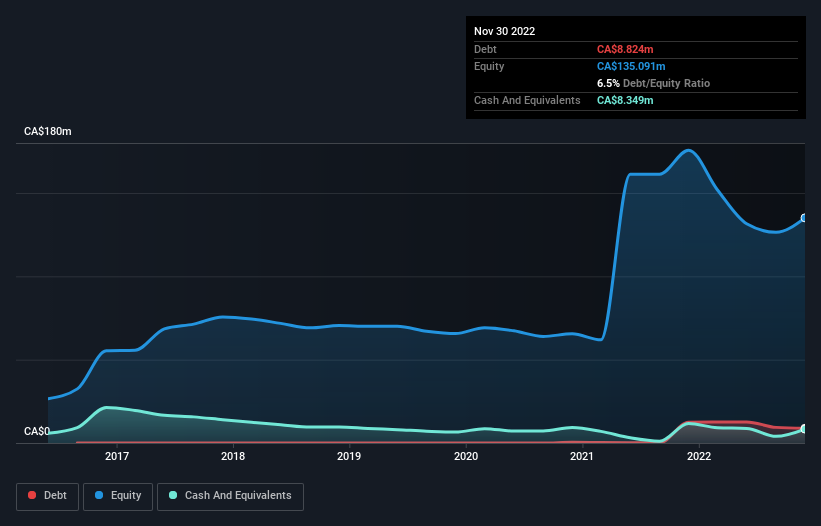Legendary fund manager Li Lu (who Charlie Munger backed) once said, 'The biggest investment risk is not the volatility of prices, but whether you will suffer a permanent loss of capital.' When we think about how risky a company is, we always like to look at its use of debt, since debt overload can lead to ruin. Importantly, GoldMining Inc. (TSE:GOLD) does carry debt. But should shareholders be worried about its use of debt?
When Is Debt Dangerous?
Debt is a tool to help businesses grow, but if a business is incapable of paying off its lenders, then it exists at their mercy. Ultimately, if the company can't fulfill its legal obligations to repay debt, shareholders could walk away with nothing. However, a more common (but still painful) scenario is that it has to raise new equity capital at a low price, thus permanently diluting shareholders. Having said that, the most common situation is where a company manages its debt reasonably well - and to its own advantage. The first step when considering a company's debt levels is to consider its cash and debt together.
View our latest analysis for GoldMining
How Much Debt Does GoldMining Carry?
As you can see below, GoldMining had CA$8.82m of debt at November 2022, down from CA$12.5m a year prior. However, because it has a cash reserve of CA$8.35m, its net debt is less, at about CA$475.0k.

How Strong Is GoldMining's Balance Sheet?
According to the last reported balance sheet, GoldMining had liabilities of CA$11.0m due within 12 months, and liabilities of CA$1.25m due beyond 12 months. Offsetting these obligations, it had cash of CA$8.35m as well as receivables valued at CA$374.0k due within 12 months. So it has liabilities totalling CA$3.52m more than its cash and near-term receivables, combined.
Having regard to GoldMining's size, it seems that its liquid assets are well balanced with its total liabilities. So it's very unlikely that the CA$247.1m company is short on cash, but still worth keeping an eye on the balance sheet. Carrying virtually no net debt, GoldMining has a very light debt load indeed. When analysing debt levels, the balance sheet is the obvious place to start. But ultimately the future profitability of the business will decide if GoldMining can strengthen its balance sheet over time. So if you want to see what the professionals think, you might find this free report on analyst profit forecasts to be interesting.
Since GoldMining has no significant operating revenue, shareholders probably hope it will develop a valuable new mine before too long.
Caveat Emptor
Importantly, GoldMining had an earnings before interest and tax (EBIT) loss over the last year. Indeed, it lost CA$15m at the EBIT level. Considering that alongside the liabilities mentioned above does not give us much confidence that company should be using so much debt. So we think its balance sheet is a little strained, though not beyond repair. Another cause for caution is that is bled CA$11m in negative free cash flow over the last twelve months. So to be blunt we think it is risky. The balance sheet is clearly the area to focus on when you are analysing debt. But ultimately, every company can contain risks that exist outside of the balance sheet. For example, we've discovered 2 warning signs for GoldMining (1 is concerning!) that you should be aware of before investing here.
If you're interested in investing in businesses that can grow profits without the burden of debt, then check out this free list of growing businesses that have net cash on the balance sheet.
New: Manage All Your Stock Portfolios in One Place
We've created the ultimate portfolio companion for stock investors, and it's free.
• Connect an unlimited number of Portfolios and see your total in one currency
• Be alerted to new Warning Signs or Risks via email or mobile
• Track the Fair Value of your stocks
Have feedback on this article? Concerned about the content? Get in touch with us directly. Alternatively, email editorial-team (at) simplywallst.com.
This article by Simply Wall St is general in nature. We provide commentary based on historical data and analyst forecasts only using an unbiased methodology and our articles are not intended to be financial advice. It does not constitute a recommendation to buy or sell any stock, and does not take account of your objectives, or your financial situation. We aim to bring you long-term focused analysis driven by fundamental data. Note that our analysis may not factor in the latest price-sensitive company announcements or qualitative material. Simply Wall St has no position in any stocks mentioned.
About TSX:GOLD
GoldMining
A mineral exploration company, engages in the acquisition, exploration, and development of gold and copper assets in the Americas.
Flawless balance sheet and slightly overvalued.
Similar Companies
Market Insights
Community Narratives


Recently Updated Narratives

Constellation Energy Dividends and Growth

CoreWeave's Revenue Expected to Rocket 77.88% in 5-Year Forecast

Bisalloy Steel Group will shine with a projected profit margin increase of 12.8%
Popular Narratives


MicroVision will explode future revenue by 380.37% with a vision towards success


NVDA: Expanding AI Demand Will Drive Major Data Center Investments Through 2026



